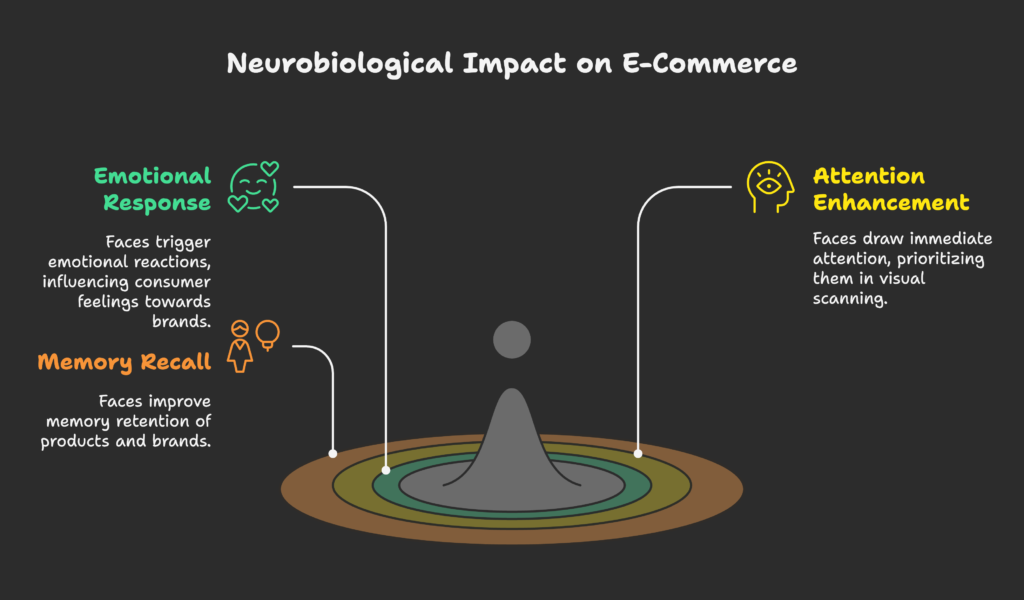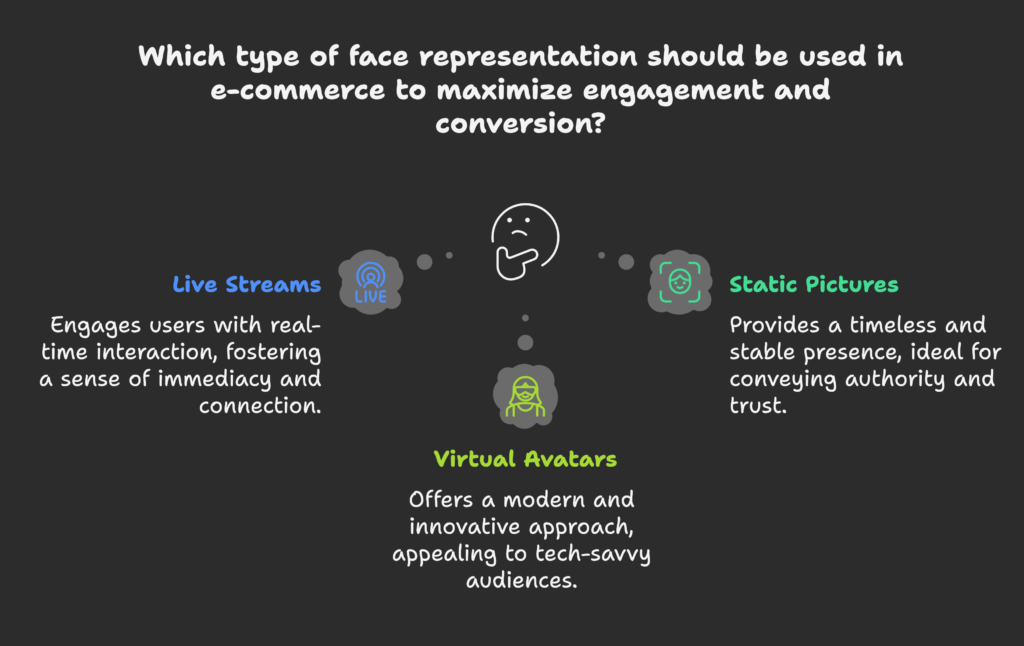Have you ever locked eyes with a smiling brand ambassador on a product page and felt a sense of trust almost instantly? Or found yourself lingering on a site that features friendly staff photos, even if you weren’t planning to buy anything? In this article, you’ll discover how simply seeing a human face can trigger deep neurological responses – leading to higher sales, stronger trust, and better overall engagement. Ready to see how faces and e-commerce form a powerful combination? Let’s begin!
In this section: We’ll explore the gap between traditional physical shopping experiences and the current digital environment, look at the fundamental brain systems that respond to faces, and discuss how savvy brands turn a glimpse of a human face into a major boost in conversions.
The Evolution of Human Connection in Digital Commerce
Online shopping is highly convenient, but often lacks the human warmth found in real stores. People are wired to seek social cues – a friendly nod, a genuine smile, or eye contact. These quick, subtle signals build trust in face-to-face transactions. As commerce shifted online, that human layer vanished, replaced by static photos or product lists. Now, e-commerce has advanced to incorporate more human elements, from staff photos and live chats with real reps to interactive video calls. Statistically, as digital adoption soars, consumer distrust also rises – meaning businesses that add a personal human touch stand out and foster deeper relationships.
The Neuroscience of Face Processing
Faces hijack our attention more strongly than any other visual stimulus. Our *fusiform face area (FFA)*, nestled in the temporal lobe, specializes in rapid face detection and recognition. We’re evolutionarily primed to read expressions for signs of friendliness or threat. Even in quick scrolling, a face can stop us cold, prompting a mental “Check this out!” As a result, e-commerce experiences that feature even a simple, welcoming face can drastically alter how we judge a brand or product.
Business Significance of Facial Elements in E-commerce
- Immediate Trust: Humans subconsciously trust a site more if it displays credible human faces, especially genuine smiles or staff photos.
- Conversion Boost: Studies show that interfaces featuring real faces can see better user engagement and improved purchase rates.
- Long-Term Retention: Faces make a brand memorable. Customers who associate a friendly face with your brand often come back for repeat purchases.
Next, let’s explore the brain’s deeper workings: which areas handle face recognition, how emotions factor in, and why a single human face can alter an entire shopping journey.
Neurobiological Foundations of Facial Response
In this section: We’ll dive into the specific brain structures behind face recognition, see how emotional assessment happens so quickly, and learn how these responses enhance attention and memory in e-commerce contexts.

Key Brain Structures in Face Processing
- Fusiform Gyrus: The champion of face recognition, picking out facial features with stunning speed.
- Amygdala: Reacts to emotional cues, like a smiling or frowning face, guiding how we feel toward that person (or brand).
- Prefrontal Cortex: Interprets social nuances, forming more complex judgments like trust or approachability.
The Emotional Processing System
Seeing a face triggers emotional circuits. *Facial mimicry* can occur, making us subtly mirror an expression we see on screen, fostering empathy. *Dopamine* and *oxytocin* might surge if the face looks friendly, forging a “this brand is safe and pleasant” impression. Essentially, a face-based approach can push consumers into a warm, receptive mindset faster than text alone ever could.
Attention and Memory Enhancement
- Face Preference: Our brains default to scanning faces first before other design elements, ensuring immediate focus on that section.
- Stronger Recall: Pairing a product or brand name with a face helps it stick in memory. We recall human details more readily than purely abstract images.
With the science in mind, let’s look at studies proving that faces do, in fact, shape user behavior – from eye movements to final purchase decisions.
Research Evidence on Facial Impact in E-commerce
In this section: We’ll survey eye-tracking results, fMRI and EEG data, plus real-world usage patterns. You’ll see how faces draw stares, evoke trust, and significantly influence outcomes like cart abandonment or brand recall.

Eye-Tracking Studies on Facial Attention
- Focus on Faces: Eye-tracking reveals that users fixate on faces within the first seconds on a page, often ignoring other nearby text at first glance.
- Navigation Effects: If a face is looking or pointing to a “Buy Now” button, clicks on that button tend to rise. Our gaze follows the face’s direction.
- Demographic Differences: Younger shoppers might dwell longer on dynamic images of peers, while older groups may prefer a calm, authoritative face. Strategize accordingly.
Neuroimaging Research Findings
*fMRI studies* have documented heightened neural activation when participants view a website featuring large, friendly faces. EEG experiments confirm spikes in engagement within milliseconds. The *trustworthiness assessment* begins almost instantly, building or dampening brand perception in real time. Meanwhile, *static vs. dynamic face presentations* can produce different patterns: videos featuring an approachable face can generate more emotional resonance than still images.
Behavioral and Conversion Metrics
- Purchase Intent: Pages with human faces can see more than a 10% jump in add-to-cart rates, reflecting a surge in trust.
- Cart Abandonment: A subtle face near the final checkout might reduce last-minute doubts. The sense of “a real person is behind this” can reassure users.
- Brand Recall: Even if users don’t buy immediately, the memory of a warm face can spark them to return or mention the site to friends.
So, faces matter. But how do we incorporate them? Let’s examine the variety of face types—live streams, static pictures, or even virtual avatars—and see which ones might fit your brand best.
Types of Facial Representations in E-commerce
In this section: We’ll categorize how e-commerce uses faces, from real-time streams to static staff photos or even AI-generated images. We’ll see the pros, cons, and best-case usage scenarios.
Live Streaming and Real-Time Human Interaction
- Influencer Streams: Many brand ambassadors speak directly to the audience via live video, forging immediate human connection. The streamer’s *facial expressions* and *enthusiasm* can drive quick sales.
- Shoppertainment: In some markets, live streaming is huge – seeing a personable face model or demonstrate the product fosters an immediate sense of trust.
- Product Type Relevance: If it’s a visually demonstrable item (clothes, cosmetics, electronics), seeing a person use it real-time can *skyrocket* conversions.
Static Images of People
Even a simple staff photo or a lifestyle shot with a real person can do wonders. *Authenticity* is key: staged stock photos with forced smiles may actually reduce trust if they look fake. But genuine, relevant faces (happy customers, or staff standing behind the brand) reassure potential buyers. *Diversity in representation* is also crucial – ensuring your brand welcomes all cultural or demographic backgrounds fosters broader appeal.
Artificial and Virtual Faces
- AI-Generated Faces: They can appear eerily realistic but risk venturing into the “uncanny valley” if not carefully refined. Users can sense something is off, undermining trust.
- Virtual Anchors: Some e-commerce sites embed animated avatars that greet users or guide them through steps. If done well, it can simulate a personal assistant; if it feels too robotic, it may turn users away.
- Personification of Chatbots: Simple graphical representations of support “agents” give a more human vibe than a plain text interface. But brand authenticity still demands a consistent “voice.”
We’ve seen the forms of face usage. To confirm if it’s actually boosting sales, you need robust measurement. So let’s check the methods for capturing user reactions, from advanced biometrics to straightforward A/B testing.
Measurement and Research Methodologies
In this section: We’ll highlight ways to prove that faces help conversions: from imaging consumer brains to analyzing on-site behaviors like dwell time and click patterns. Combining methods yields the clearest picture of success.
Neuroimaging Techniques
- fMRI: Great for detailed neural activation mapping. Typically used in academic or large-scale brand labs, not everyday marketing. Yet it shows how strongly faces engage the amygdala or FFA.
- EEG: Measures real-time brain waves, capturing immediate engagement or emotional response. Light enough for limited in-lab user sessions.
While cutting-edge, these can be expensive or time-consuming. They do, however, confirm the raw power of faces in forging deeper engagement in microseconds.
Facial Expression Analysis
- Automatic Facial Coding: Tools that read micro-expressions to gauge user emotions while browsing. Some e-commerce tests find participants unconsciously smile or show interest when encountering certain images.
- Machine Learning Classification: Advanced software can interpret user expressions in real time, adjusting site or product recommendations accordingly.
Biometric and Behavioral Measures
- Eye-Tracking: Pinpoints exactly where on the page visitors look first and for how long. If 80% focus on the face, you know it’s pivotal.
- Skin Conductance or Heart Rate: Subtle signals that indicate emotional arousal while users view certain images or watch live demonstrations.
- Behavior Data: Look at dwell time, bounce rates, or cart completions before and after adding faces to your design or store. A direct, practical measure of impact.
By combining such measurements, you confirm whether faces truly matter in your context. Next, let’s see how to apply these insights in your platform’s design, customer service, and product demos.
Practical Applications for E-commerce Platforms
In this section: We’ll break down specific ways you can incorporate faces into your site or marketing: from strategic homepage design and personalized help, to guiding customers with subtle psychological cues.
Strategic Face Integration in Interface Design
- Placement: Put a staff or model face near your CTA, or have them glancing toward the “Buy Now” button. People follow the gaze direction.
- Balancing Product Focus: Don’t overshadow your items. The face should complement or point to them, not overshadow them entirely.
- Cultural Sensitivity: Some cultures or audiences might prefer minimal personal images, so test what resonates. Localizing the “human presence” can pay off big.
Customer Service and Trust Building
- Human vs. Chatbot Face: A real agent’s friendly thumbnail fosters closeness, while a cartoonish avatar might amuse or annoy. Evaluate your brand tone.
- Staff Profiles: For B2B or specialized markets, listing real employee photos (with short bios) helps clients feel they know the team, spiking trust.
- Continuity Across Touchpoints: If your brand rep is pictured on the site, also feature them in email sign-offs. Consistency cements a personal bond.
Product Demonstration Optimization
*Video demos* showing a real human using or unboxing the product can blow away plain text descriptions. Visualizing how someone interacts with it fosters “If they can do it, so can I!” Alternatively, *live webinars or Q&A streams* put a face front and center, letting watchers see genuine enthusiasm or expertise. Also, *user-generated content* with customers’ faces can double as social proof, showing real, unfiltered satisfaction and authenticity.
Of course, not all is perfect. Let’s address the potential ethical pitfalls and user privacy concerns that come with analyzing or leveraging facial response. We’ll ensure you don’t step over the line.
Ethical Considerations and Limitations
In this section: We’ll consider how to ethically gather data on user facial reactions, the difference between friendly marketing and manipulative tactics, and the necessity of representation in faces shown to users.
Privacy and Consent Issues
- Facial Recognition Tech: Some advanced e-commerce experiments might want to track emotional expressions. This demands transparent user consent—scanning someone’s face unawares is intrusive.
- Data Regulations: Regions like the EU with strict privacy laws (GDPR) may limit how you handle face-based analytics. Always get user permission and clarify data usage.
Manipulation Concerns
- Over-Personalization: If you adapt your site based on micro-expressions, users might feel manipulated. Always aim for beneficial, respectful design choices.
- Cultural Nuance: Some societies might distrust a face that looks “too perfect,” while others might interpret a big smile as suspicious. Lean on local insights to avoid backfires.
Representation and Diversity
- Broader Demographics: People want to see themselves reflected. Show a variety of ages, skin tones, and body types to foster real inclusivity.
- Avoiding Tokenism: Genuinely incorporate diverse faces, not just for show. Reflect the reality of your brand’s audience meaningfully.
Finally, let’s glimpse the future: AI shaping custom faces for each visitor, or VR experiences letting you “meet” the brand’s staff in 3D. It’s all on the horizon, but how do we seize it effectively?
Future Trends and Innovations
In this section: We’ll look at how advanced AI, mixed reality, and personalization might revolutionize the face-based experience in e-commerce. You’ll see the next wave of “human connection” at scale.
Artificial Intelligence Advancements
- AI-Generated Faces: The day might come when each visitor sees a tailored face reflecting demographics or preferences, boosting resonance. But mind the “uncanny valley” effect!
- Emotion Detection: Real-time camera-based systems could adapt product recommendations if they sense a user is bored or excited. Yet ethical lines must remain clear.
Augmented and Virtual Reality Applications
*AR overlays* might let a shopper “meet” a brand representative in their own living room, bridging the gap between remote shopping and personal engagement. VR showrooms could highlight staff avatars who speak and move realistically, intensifying that feeling of trust. The cost is significant, but for certain high-ticket or experiential brands, the reward can be massive brand loyalty.
Personalization and Customization
- Emotional Profiling: Sites may track user reactions historically, showing more or fewer faces depending on personal preference. Some users might love it; others find it intrusive.
- Adaptive Facial Elements: E.g., a brand rep’s photo on the homepage changes expression if you linger or come back multiple times. Quirky or potentially creepy—test carefully!
Ready to put it all into action? Let’s sum up a step-by-step strategy for your e-commerce site, ensuring a well-orchestrated approach to adding real “human touches.”
Implementation Strategy for E-commerce Businesses
In this section: We’ll provide a blueprint: from analyzing your existing brand presence, to deciding how and where to integrate faces, to measuring the final impact. Let’s get practical!
Assessment and Planning Framework
- Audit Current Setup: Check if your site currently uses any human imagery. How do users respond? Are you missing valuable face-based elements?
- Opportunity Spotting: Identify key friction points (like sign-ups or cart pages) or brand touchpoints where a friendly face might calm doubts or build confidence.
- Measurement Metrics: Decide if you’ll track bounce rate, average session time, or direct conversion lifts after adding faces. Setting baseline data is crucial.
Testing and Optimization Protocols
- A/B Testing: Show half your audience an interface with staff or model faces, the other half a face-less version. Compare engagement or revenue differences.
- Neurological Measures (if feasible): If you have the resources, gather EEG or eye-tracking data for deeper insights. Otherwise, rely on standard analytics and user feedback.
- Iterative Improvement: Tweak angles, expressions, or image placement over time. Use real-time metrics to refine your approach.
Cross-Functional Integration
- Marketing & Design Collaboration: Marketers define the brand message, while designers handle the visual synergy with faces. Consistency ensures a cohesive brand personality.
- Tech & Dev Coordination: Ensure site performance remains smooth. Large, high-res images of people can slow load times if not optimized, harming user experience.
- Long-Term Strategy: Keep refining face-based elements as your brand evolves. Rotating fresh real or influencer photos can maintain novelty and authenticity.
We’ll close now with top recommendations for aligning science-backed face integration with your brand strategy, plus the bright future ahead in bridging digital commerce and human warmth.
Conclusion and Strategic Recommendations
In this section: We’ll finalize the main findings, offering a quick blueprint to bring your brand closer to its audience through the science of faces. Let’s ensure you’re ready to tap into the fundamental human desire for connection.
Core Principles Summary
- Faces Trigger Trust: Humans are wired to respond emotionally to faces, so using them effectively fosters immediate positivity.
- Focus on Authenticity: Real, relevant faces outshine stock or AI images that feel unnatural or forced.
- Enhance Key Touchpoints: A friendly face near sign-ups, checkouts, or big product intros can reduce doubts and push conversions.
- Test & Refine: From quick A/B tests to advanced analytics, gather data to see which expressions or angles best resonate with your unique audience.
Implementation Roadmap
- Initial Audit: Evaluate your site or app for spots where a face might convey trust or excitement.
- Resource Allocation: Decide if you need new photography, influencer partnerships, or in-house visuals. Budget for potential design changes.
- Measurement Setup: Track relevant metrics (conversions, dwell time, user feedback). Possibly incorporate basic eye-tracking or engagement analytics if feasible.
- Cycle of Improvement: Once integrated, see how your audience reacts. Tweak or expand the concept to other site areas or marketing channels.
The Future of Human Connection in E-commerce
We’re heading toward a hyper-personalized digital realm where AI might craft faces precisely for each shopper’s preferences. But no matter how advanced we get, the fundamental truth remains: seeing a smiling, trustworthy face resonates on a deep, primal level. As e-commerce evolves, successfully blending technology with genuine human elements will be a top competitive edge, bridging the distance between brand and buyer in the online space.
Quick Note: If you’re a Shopify merchant looking to add real human elements to your digital store, consider the Growth Suite app. It helps you effortlessly insert staff or customer photos, measure their impact on your performance, and continuously refine your approach—so your brand builds a deeper, more personal connection with each visitor.
References
- Wang, X., et al. (2023). Influence of Perceived Value on Consumers’ Continuous Purchase Intention in Live-Streaming E-Commerce—Mediated by Consumer Trust. Link
- ISmile Technologies. (2022). Facial Emotion Recognition in Neuromarketing. Link
- Vimi.co. (2023). Faces, Brains and B2B Marketing – A Digital Agency’s Perspective. Link
- JRNI. (2025). The Power of Human Connection in an Online World. Link
- MDPI. (2024). The Effects of Live Streamer’s Facial Attractiveness and Product Type on Consumer Purchase Intention. Link
- NCBI. (2023). Mapping of facial and vocal processing in common marmosets with ultra-high field fMRI. Link
- Explorer Research. (2024). The Power of Eye Tracking for E-Commerce Shopper Insights. Link
- Frontiers. (2023). Automatic facial coding predicts self-report of emotion in marketing. Link
- ArXiv. (2024). Generative Retrieval with Preference Optimization for E-commerce Search. Link
- Semantic Scholar. (n.d.). Integrating Facial Cues of Threat into Security Warnings – An fMRI and Field Study. Link
- Frontiers. (2018). Neural Correlates of Facial Mimicry: Simultaneous Measurements. Link
- Semantic Scholar. (2024). Analysis of Digital Transformation Problems of Alibaba E-commerce Platform and Countermeasures to Enhance Personalised Services. Link
- Semantic Scholar. (2024). AI in Neuromarketing: Understanding Consumer Emotions and Behavior through Machine Learning. Link
- Semantic Scholar. (n.d.). Exploring Consumer Citizenship Behavior by Personification of E-Commerce Virtual Anchors Based on Shopping Value. Link
- Semantic Scholar. (2024). Comparison of Studies Conducted in the Field of Neuromarketing and Artificial Intelligence Using Bibliometric Method. Link
- Semantic Scholar. (f2024). Research on the Strategy of Government Support for the Effective Development of Rural E-Commerce. Link
- New Neuromarketing. (2016). 5 Neuromarketing techniques every marketeer should know about. Link
- Semantic Scholar. (n.d.). Model for Responsive Agriculture Hub via e-Commerce to Sustain Food Security. Link
- Acowebs. (2024). How To Transform Your eCommerce Strategy with Neuromarketing. Link
- TOJCAM. A Study on Neuromarketing Potential, Problems and Challenges in E-Commerce Sector. Link



